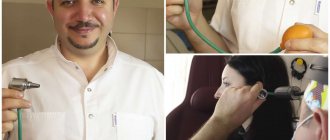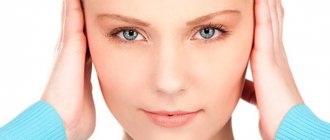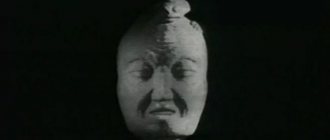Causes of ear congestion
In addition to swelling caused by a cold, ears can become blocked due to some physical reasons:
- Pressure changes when flying on an airplane, riding in an elevator, riding on attractions;
- Getting water into the ear canal while swimming or diving;
- Rhinosinusopathy due to hormonal imbalance during pregnancy.
Also, conditions such as cerumen plug, deformation of the nasal septum, foreign body in the ear, hypertension, taking medications, osteochondrosis, etc. can be the causes of ear congestion.
Causes of ear congestion
There are many reasons that can lead to such a condition. The most common factors:
- Changes in atmospheric pressure. This is one of the most common factors that arise when flying in an airplane, diving to depths and climbing mountains. Typically, the pressure in the eardrums is within certain limits, and with sudden changes in atmospheric pressure, the middle ear cannot cope with its equalization. This influence leads to the child complaining of ear congestion without pain. This condition can be short-term or observed throughout the entire flight. When the atmospheric pressure returns to normal, this sign disappears.
- The presence of eustachitis - a catarrhal inflammatory process in the Eustachian tube, accompanied by ear congestion. The risk of this pathology is that hearing gradually deteriorates. In medicine, this disease is also called tubo-otitis, salpingo-otitis, tubotympanitis. The reason for the development of this disease lies in the penetration of pathogenic microorganisms from the respiratory system or nasopharynx into the cavity of the auditory tube. A similar phenomenon is usually observed against the background of influenza, sore throat, pharyngitis, rhinitis, sinusitis, and adenoiditis. To reduce swelling of the mucous membranes in the Eustachian tube, the use of vasoconstrictors (nasal drops) and antihistamines is indicated. The use of physiotherapeutic procedures is also recommended. When acute phenomena in the nasal cavity and nasopharynx are eliminated, the ear is ventilated. Then pneumomassage is performed to remove transudate from the middle ear. The doctor selects the therapeutic regimen individually, taking into account the nature of the pathology.
- Development of otitis. With this disease, the ears not only become blocked, but also cause severe pain. This condition is accompanied by strong crying of the child and whims. At the early stage of the development of the disease, there are no painful sensations; the child simply complains that the ear is clogged. It is worth considering that only a doctor can accurately diagnose the disease. Most often, with such a pathology, you need to immediately undergo a course of antibiotic therapy. It is imperative to consult with an ENT doctor, even in the absence of pain, in order to receive correct and timely treatment.
- Wax plugs in the ears. This is a kind of barrier in the ear canals, which causes the feeling that the ears are blocked. Over time, sulfur accumulates in the area of the external auditory canal due to a narrow auditory tube, large cerumen secretion, and improper ear hygiene. An ENT doctor can easily fix this problem. Moreover, the treatment is quick and painless.
- Presence of a foreign object. Often children stick an object into their ear while playing. It must be removed from the external auditory tube in time, otherwise it will lead to ear congestion or other more serious problems.
- Getting water into the ears when swimming in a bath, pool or open water. Most often in such a situation, water is removed without outside help. If this does not happen, you can tug your earlobe, tilting your head on your shoulder. You can also tilt your head to one or the other shoulder. It is recommended to create a vacuum by tilting your head to the side and pressing your palm firmly against your ear.
- Increased blood pressure levels. Such suspicions should arise if a child experiences frequent ear congestion for no apparent reason. If your blood pressure is abnormal, you need to consult a pediatrician and undergo an appropriate examination to accurately determine the cause of this phenomenon. In such a situation, adjustments to the child’s daily routine and diet and frequent walks outside are required. It is also recommended to maintain an active lifestyle and perform moderate physical activity.
Symptoms of ear congestion
When the ear is blocked, a person’s well-being does not change, but he begins to perceive his own voice differently, external sounds seem muffled, and sudden changes in body position may be accompanied by dizziness and nausea.
If the sound is not perceived in full due to a mechanical obstacle, accumulation of sulfur, narrowing of the ear canal, etc., additional symptoms will be the same as when water gets in.
More complex problems associated with the spine and increased blood pressure can provoke:
- Noise and ringing in the ears;
- Feeling of heaviness in the head;
- Headaches and dizziness.
With Meniere's syndrome and otosclerosis, hearing decreases gradually.
Hygiene procedures
Maintaining hygiene helps not only to clean the ears from dust and dirt, but also to protect them from the effects of pathogenic microorganisms. If hygiene measures are not followed, the likelihood of the formation of various pathologies increases and hearing acuity is significantly reduced.
Do not forget that cleaning healthy ears occurs without intervention. Nature has provided our ears with such a function as self-cleaning. The sulfur and sebaceous glands located in the ears secrete a special substance that protects the auditory organs from damage. In the ears, epithelial cells are constantly being renewed, and this process occurs in the direction from the middle ear to the external meatus.
In addition, the structure of the temporomandibular joint favors the self-cleaning function. In the process of chewing food, talking, coughing, sneezing, laughing and other jaw movements, accumulated wax and dead epithelial cells are removed from the ear.
Parents just need to make sure that the earlobes, folds and behind-the-ear space are clean. To clean, use water and soap. You should not use ear swabs for cleaning, as this leads to the pushing of wax into the auditory tube. To clean the ears of young children, you can use special cotton swabs with a limiter, after moistening them with water.
Remember: earwax is not dirt. There is no need to clean it thoroughly. Frequent and deep cleaning leads to more active sulfur production and even greater accumulation.
Sulfur can be dark, light and dry. Only when dark wax is secreted does a brown ring form near the external auditory canal. Moreover, you need to get rid of only these accumulations of sulfur without penetrating deep into the ear. For an adult, cleaning the ears is not difficult; you just need to wash them using water and soap as far as your index finger can reach.
In what cases should you consult a doctor?
In order to eliminate ear congestion in a child and restore auditory function, the cause of this condition must be accurately established. For accurate, timely and professional elimination of ear congestion and many other problems, you should seek specialized help at the First Children's Medical Center. You should not self-medicate at home, as this can lead to serious complications. If your ears are blocked, you need to visit a doctor.
The health of young children must be monitored, protected from negative influences to prevent the development of the inflammatory process and undesirable consequences. Children's ears are very vulnerable and are more susceptible to inflammation. Infections that do not harm an adult’s body are dangerous for a child’s.
The child may complain of stuffiness and pain in the ears. In some cases, this condition disappears without outside help, but this sign should not be ignored. When a child has a blocked ear, you should definitely visit a pediatrician and an ENT doctor. Moreover, you need to try to prepare the baby for a visit to the doctor’s office in advance, so as not to scare the child.
When to go to the ENT doctor?
Constant ear congestion, even without pain, is a cause for concern. Treatment must be directed at the cause, which may be very serious. In severe cases, the patient may require surgery.
It is necessary to consult a doctor in cases where the feeling of congestion does not go away for a long time, the body temperature rises, there is pain and dizziness, any fluids are discharged from the ear, if the hearing loss was preceded by an injury or serious illness.
Folk remedies
Elimination of ear canal congestion is possible only after getting rid of the problem that led to the development of this unpleasant symptom. However, you can speed up the process using folk remedies. Remember that the use of any recommendations from healers should be discussed with your doctor first. Otherwise, you risk, in addition to the main disease, getting many other problems. Among the huge number of folk remedies for getting rid of ear congestion, the following can be particularly highlighted:
- Warming compresses. Any such procedures should be carried out only if you are completely sure that there are no purulent or inflammatory processes in the ear. It is recommended to warm up with camphor alcohol. For this purpose, gauze or a cotton swab is moistened in the specified composition, wrung out a little and applied to the auricle. The duration of one session is about 20 minutes. It is recommended to carry out warming three times a day until the condition improves.
- Inhalation with decoctions of medicinal herbs. 2 tbsp. l. pour dry raw materials with cold water and bring to a boil. Then, covered with a towel, breathe in the steam emanating from the container with the medicinal decoction. Carry out inhalations twice a day for a week until the buzzing (ringing) in your ears stops.
- Washing with saline solution. This popular advice is used if your ears periodically become blocked due to a runny nose. The procedure is carried out by intranasal administration of a hypertonic solution. The latter is prepared at the rate of 2 tsp. salt per glass of water. The procedure for washing the nasal passages is carried out using a pipette several times a day.
Read also
Earache
Ear pain is common among children, but it can also affect adults.
Ear pain in adults and children can affect both one or both ears, but most often it is a one-sided process. Symptoms... Read more
Adenoids
Probably, in modern times there is not a single parent who has not heard at least once about adenoids. This is the first question that is asked at an appointment with an ENT doctor: “Do we have adenoids?” What are adenoids?...
More details
Vasomotor rhinitis
The concept of vasomotor rhinitis Vasomotor rhinitis is an inflammatory process in the nasal cavity. Irritants or allergens can cause this inflammation. Sometimes there are cases when there is no specific reason...
More details
Nasal congestion in a child
What causes nasal congestion in a child Nasal congestion in a child is a common occurrence. Most often, this problem is caused by viral infections, such as acute respiratory viral infections, influenza, and less commonly, nasal septum defects,…
More details
Sore throat
A sore throat is a pain, scratching, or irritation in the throat that gets worse when you swallow. The most common cause of this disease is viruses, namely colds (ARVI) or...
More details
Treatment of acoustic neuritis
Depending on the nature of the course of cochlear neuritis, treatment can pursue one of two goals:
- In acute illness, as a rule, they strive to restore hearing.
- In chronic cases, they try to stabilize the process so that hearing does not decline further.
In the acute form, hospitalization of the patient in a hospital is indicated.
Drugs for the treatment of acoustic neuritis
Medications used:
- Vasodilators - help normalize microcirculation and improve the nutrition of nerve fibers.
- Antiplatelet agents - reduce blood viscosity, thereby improving blood flow in small vessels.
- Neuroprotectors - stop and prevent damage to nerve tissue.
- Nootropics - improve the functioning of the nervous system.
- Antibiotics - used if the disease is caused by a bacterial infection.
- Hormonal anti-inflammatory drugs - help reduce inflammation.
- Infusion therapy - intravenous infusions of various solutions through a dropper help remove toxins from the body that have led to damage to the nervous tissue.
Physiotherapy procedures are prescribed: electrical stimulation, phonophoresis with medications. Sometimes they resort to acupuncture. Sometimes surgical treatment is required for cochlear neuritis:
- Installation of a cochlear implant - a prosthesis that helps partially restore hearing.
- Removal of hematoma, tumor and other formations that compress nerve fibers and cause neuritis.
- Removal of a neuroma , a benign tumor of the auditory nerve.
- Constant painful tinnitus , recurring severe dizziness.
If treatment is started on time, hearing can be restored in approximately 50% of patients, and in another 40% significant improvements can be achieved. In the chronic form of the disease, hearing restoration becomes impossible; the doctor tries to prevent its further deterioration.
Take care of yourself, book an ENT consultation now
Message sent!
expect a call, we will contact you shortly
Acoustic neuritis leads to a condition called sensorineural hearing loss.
Symptoms of the disease
Acoustic neuritis manifests itself in two main symptoms:
- Hearing loss: the perception of sounds deteriorates, a person understands other people’s speech worse. Over time, complete deafness may occur.
- Noise in the ears: it can vary in pitch and is caused by inflammation and poor circulation.









